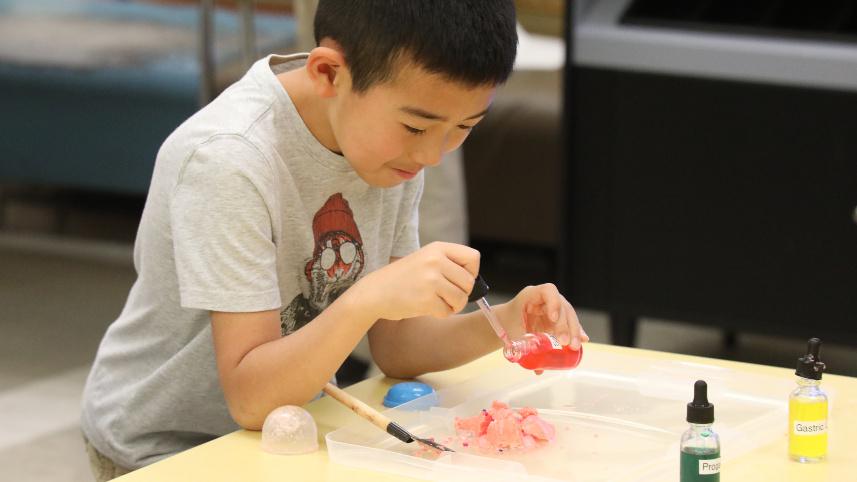While playing “In Case of Cellulose,” participants choose to simulate the digestion of a cow, horse, panda, or a human. We create a digestive bolus of chewed leaves using baking soda, citric acid, cornstarch, and food coloring (you might call it a bath bomb in other circumstances). To digest these boli, participants must first chemically and mechanically process them in the “stomach”—a tray— using digestive enzymes. As a colorful chemical reaction takes place before their eyes, they first notice a few “nutrients” appearing—small, colorful, beads—before stumbling across a hard plastic ball that is unreactive to digestive enzymes. This ball of cellulose contains significantly more nutrients but is incredibly difficult to open. Depending on their chosen species, participants will then get to experience different evolutionary strategies for digesting cellulose and absorbing nutrients in the intestines as they carry the bolus through the “intestines”—a long, collapsible tunnel. Once in the intestines, they will have to match the nutrition they found with the enzyme or part of the microbiome that helps it be absorbed.
Cellulose has been an important structural component of plants since the Paleozoic, but digesting it has presented a challenge for animals. In fact, no animal can digest cellulose without the help of microorganisms inhabiting their guts, though the type and location of these digestive helpers vary. Foregut fermenters, like cows, break down cellulose in their first few stomachs, but need to regurgitate, chew their cud, and pass the bolus through the last few stomachs in order to absorb protein. Hindgut fermenters like horses, by contrast, use the microbiome located primarily in their cecum to break down cellulose. Pandas present a particularly weird case, as they subsist almost entirely on high-cellulose food, but have a short, carnivore gut that makes fermentation impossible and lacks the microbiome to process cellulose (though evidence is mixed on this last point).
While every strategy allows animals to extract at least some nutrition from plant resources, evolutionary trade-offs exist for all three animals. Foregut fermenters extract fewer nutrients overall, while hindgut fermenters often have to rest during digestion. Furthermore, the overall strategy of subsisting on plant resources means that animals often have to spend huge parts of their day foraging. Many participants were shocked to see how little caloric value they get out of each resource and how many hours of their day they would have to spend chewing and digesting in order to stay alive. Pandas, who get almost no nutrients from the leaves they eat, have devised an incredibly risky strategy for digestion, where any deviation in plant resource availability can end in their death. For our participants, it is also an important lesson in how adaptive strategies work.





